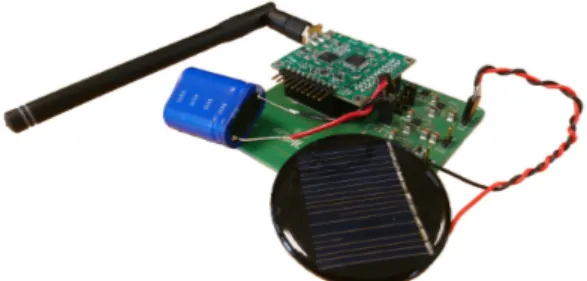HAL Id: hal-01819048
https://hal.archives-ouvertes.fr/hal-01819048
Submitted on 19 Jun 2018
HAL is a multi-disciplinary open access
archive for the deposit and dissemination of
sci-entific research documents, whether they are
pub-lished or not. The documents may come from
teaching and research institutions in France or
abroad, or from public or private research centers.
L’archive ouverte pluridisciplinaire HAL, est
destinée au dépôt et à la diffusion de documents
scientifiques de niveau recherche, publiés ou non,
émanant des établissements d’enseignement et de
recherche français ou étrangers, des laboratoires
publics ou privés.
Demo Abstract: Multi-source energy management for
Long Range IoT nodes
Philip-Dylan Gleonec, Jeremy Ardouin, Matthieu Gautier, Olivier Berder
To cite this version:
Philip-Dylan Gleonec, Jeremy Ardouin, Matthieu Gautier, Olivier Berder. Demo Abstract:
Multi-source energy management for Long Range IoT nodes. International Conference on
Telecommunica-tion, Jun 2018, Saint-Malo, France. 2018. �hal-01819048�
Demo Abstract: Multi-source energy management
for Long Range IoT nodes
Philip-Dylan Gleonec
Wi6labs / Univ Rennes, CNRS, IRISA philip-dylan.gleonec@wi6labs.com
Jeremy Ardouin
Wi6labs
jeremy.ardouin@wi6labs.com
Matthieu Gautier and Olivier Berder
Univ Rennes, CNRS, IRISA
matthieu.gautier@irisa.fr, olivier.berder@irisa.fr
Abstract— Energy harvesters are used in Internet of Things (IoT) networks to provide more energy to the nodes and enhance their autonomy. However, the nodes must adapt their consumed energy to variable energy harvesting conditions. Typically, an energy budget estimation (EBE) algorithm is used to calculate an energy budget based on the current energy capabilities. In this demonstration, we show an implementation and a comparison of multiple EBE algorithms on a real world LoRaWAN platform powered by different energy sources.
I. INTRODUCTION
IoT networks are usually powered by non rechargeable batteries, which limit their autonomy and require maintenance. As an alternative, the use of energy harvesting devices has been considered, which enables each node to scavenge its energy from its environment.
Most energy harvesting sources are variable, which requires the node to manage its energy to avoid power failure. To this purpose, energy management algorithms have been developed. These can be divided in two units : an EBE which calculates the best energy budget based on the node energy capabilities, and an energy allocator which decides how to spend this energy. In particular, model-free EBE algorithms, such as LQ-tracker [1] or Fuzzyman [2], are generic and can be used regardless of the energy source.
In this demonstration, we show a comparison of such algorithms, implemented on a real-world LoRaWAN IoT node powered by a multi-source energy harvesting board [3]. All algorithms are implemented in a cross-platform library, which enables both real-world implementation and simulation.
II. TESTBED ANDDEMONSTRATION
This demonstration is implemented on a LoRaWAN node platform, shown in Fig. 1, composed of a STM32L0 micro-controller and a SX1272 LoRa transceiver. The node is powered by a solar panel which provides up to 5 V and 40 mA. The solar energy is harvested by a multi-source energy harvesting board which can accept up to three simultaneous energy sources. This board uses SPV1050 converters from STmicroelectronics, and is used to charge a 7.5 F super-capacitor.
Four algorithms are compared in this demonstration. LQ-tracker takes the residual energy in storage ER as input, and
determines the best energy budget EBusing a linear regression
algorithm. Fuzzyman takes ER and the harvested energy EH
Fig. 1: Hardware evaluation platform.
as inputs, and uses fuzzy logic to determine EB. In this
demonstration, ER variation is used to estimate EH, and an
adapted rule-set has been designed. Moreover, we designed Linear T and Linear E algorithms, which respectively deliver a delay D and EB proportional to the super-capacitor state of
charge.
This demonstration uses four nodes, each running a different EBE algorithm. All nodes are connected to a remote LoRa-WAN application server through a LoRa gateway. Periodically, each node wakes-up, sends the previously measured and calculated ER, EB, D to a remote server, along with the
number of passed transmissions. The node then calculates its new EB and goes in deep-sleep until it has to send a new
transmission. The data from the nodes are fetched from the server and displayed.
III. CONCLUSION
This document presents a demonstration of a real-world implementation of energy budget estimation algorithms. These algorithms are used to control the duty cycle of LoRaWAN IoT nodes, and enable a theoretically infinite battery life. Future work will focus on improving the energy allocation, especially in the context of multiple tasks.
REFERENCES
[1] C. M. Vigorito, D. Ganesan, and A. G. Barto, “Adaptive Control of Duty Cycling in Energy- Harvesting Wireless Sensor Networks,” in IEEE Communications Society Conference on Sensor, Mesh and Ad Hoc Communications and Networks (SECON), pp. 21–30, IEEE, 2007. [2] F. Ait Aoudia, M. Gautier, and O. Berder, “Fuzzy Power Management
for Energy Harvesting Wireless Sensor Nodes,” in IEEE International Conference on Communications (ICC), IEEE, May 2016.
[3] P.-D. Gleonec, J. Ardouin, M. Gautier, and O. Berder, “Architecture of Multi-source Energy Harvesting for IoT nodes,” in IEEE Online Conference on Green Communications (Online GreenComm 2016), (n/a), Nov. 2016.
